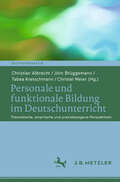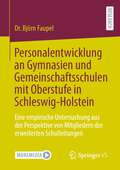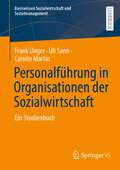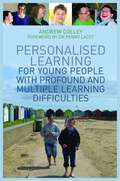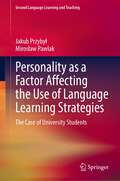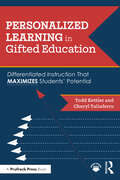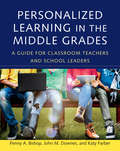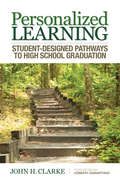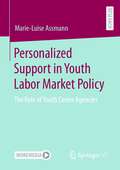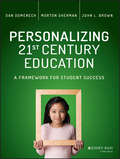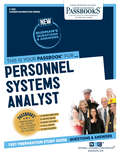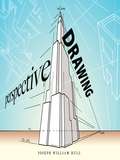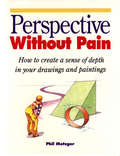- Table View
- List View
Personal, Social and Moral Education (Routledge Revivals)
by Fred SedgwickOriginally published in 1994, this book enables primary school teachers to take steps to make Personal, Social and Moral Education (PSME) central to the work of their schools. Links to the National Curriculum are implicit and explicit throughout the book, and the author covers ways in which whole staffs are to be involved in the development of PSME. Case studies of good reflective teaching are taken from many curriculum areas and from rural and urban schools. The author draws out the lessons they impart with insight, precision and principle, emphasising the values of openness, encouragement, sensitivity and respect for the children and adults engaged in the development of personal, social and moral values.
Personal, Social, Academic and Career Development in Higher Education: SOARing to Success
by Arti KumarThis book is about SOARing to Success: a pedagogy that engages individuals in a structured and supported process of personalised learning, leading to the development of transferable career management and employability skills. The SOAR model (as it has come to be known and used) provides tried and tested ways for educators to implement Personal Development Planning (PDP), Career Development Learning (CDL) and employability agendas. The theoretical concepts and practical activities that are interpreted and integrated within SOAR require all learners to make meaningful dynamic connections within and between Self, Opportunity, Aspirations and Results, through inbuilt requirements for self-reflection, action and interaction, research, analysis and synthesis. Especially relevant for regeneration in the post-pandemic world, this fully updated edition emphasises and addresses the needs to: focus more broadly on multidimensional employability, enterprise and entrepreneurship take account of post-Covid-19 educational and employment landscapes, changing labour market realities and employers’ technology-enabled recruitment methods engage proactively and positively with ways to strengthen resilience, health and wellbeing in ourselves and others tackle academic learning and assessments with digital research and information literacy skills be(come) adaptable and/or adaptive according to the demands of different contexts co-create (with social enterprise and business skills) a better world in which self-actualisation aligns with the actualisation of the UN’s Sustainable Development Goals reflect globalisation in the internationalisation of higher education (HE). Packed full of useful practical features, this text and its e-resources will help all staff and education development professionals, teachers in HE and advisers to motivate and enable students to relate their learning and achievements to the demands of life and work in our times.
Personale und funktionale Bildung im Deutschunterricht: Theoretische, empirische und praxisbezogene Perspektiven (Deutschdidaktik)
by Christian Albrecht Jörn Brüggemann Tabea Kretschmann Christel MeierDie heuristische Unterscheidung funktionaler und personaler Aspekte fachlicher Bildung wurde in den vergangenen Jahren als Teil einer Theorie der Allgemeinen Fachdidaktik u.a. von Volker Frederking in den Diskurs eingebracht. Welches Potenzial diese Begriffe für deutschdidaktische Fragestellungen besitzen, wurde bisher jedoch nicht systematisch diskutiert. Der vorliegende Band vereint theoretische, empirische und praxisbezogene Beiträge zu „personaler und funktionaler Bildung“ mit dem Ziel, eine Diskussion über die theoretische und strategische Relevanz der Unterscheidung in der Deutschdidaktik und darüber hinaus anzustoßen.
Personalentwicklung an Gymnasien und Gemeinschaftsschulen mit Oberstufe in Schleswig-Holstein: Eine empirische Untersuchung aus der Perspektive von Mitgliedern der erweiterten Schulleitungen
by Dr. Björn FaupelDas Buch zeigt den Status quo im Bereich der schulischen Personalentwicklung an Gymnasien und Gemeinschaftsschulen mit Oberstufe durch Schulleitungsmitglieder auf. Neben theoretischen Grundlagen, die sich mit der Personalentwicklung im Kontext, mit Aufgaben und Zielen, Instrumenten, Maßnahmen, Strategien, Führung, Kompetenzprofilen, Prozessen sowie dem Ressourcenmanagement und Forschungsstand beschäftigen, wird die empirische Studie bezüglich Explikationen, Vorüberlegungen sowie Überlegungen zum Fragebogen ausgeführt. Der Status quo für Personalentwicklung wird für Schleswig-Holstein herausgestellt und Einschränkungen werden mit Handlungsschwerpunkten, die ein ganzheitliches Selbstverständnis fordern – mit einer kooperativen Führung und der Schulleitung als Team, dargelegt. Neben diesen sind Beratungsgespräche der Schulleitung, schulinterne Weiterbildung und offene Gesprächsangebote bei der Verknüpfung der theoretischen und praktischen Aspekte unter Berücksichtigung des Gesundheitsmanagements zu präferieren, um die Verzahnung von schulischen, individuellen und gesellschaftlichen Zielen zu ermöglichen sowie fehlende Kenntnisse im Bereich der Personalentwicklung zu kompensieren. Wie das schulisch umgesetzt ist, erfahren Sie in diesem Buch.
Personalentwicklung in Schulen als Führungsaufgabe: Eine Bestandsaufnahme in den Ländern der Bundesrepublik Deutschland
by Barbara Muslic Felicitas Thiel Eva-Maria Lankes Norbert Maritzen Thomas Riecke-Baulecke Claudia Manuela ScheweIm Zuge schulischer Reformen wurden Aufgaben der Personalentwicklung von der Schulaufsicht an Schulen delegiert. Für die Verankerung von Personalentwicklungsaufgaben an Einzelschulen spielen rechtliche Regelungen eine entscheidende Rolle. Auf Grundlage einer systematischen Auswertung der rechtlichen Regelungen werden Aufgaben und Entscheidungskompetenzen der (schulischen) Akteure in den 16 Ländern dargestellt. Dabei stehen Schulleitungen im Fokus, zu deren zentralen Führungsaufgaben Personalentwicklung zählt.Damit wird erstmalig eine vergleichende Übersicht der bestehenden Regelungen und Maßnahmen zur Personalentwicklung in Open Access vorgelegt. Diese bietet relevantes Steuerungswissen für bildungspolitische sowie -administrative Entscheidungen und Ansatzpunkte für Forschungsfragen und -felder für künftige Forschungsvorhaben der Bildungsforschung.
Personalführung in Organisationen der Sozialwirtschaft: Ein Studienbuch (Basiswissen Sozialwirtschaft und Sozialmanagement)
by Frank Unger Uli Sann Carolin MartinDas Studienbuch „Personalführung in der Sozialwirtschaft“ bietet einen wissenschaftlich kompakten und gleichzeitig praxisnahen Einblick in die Vielfalt der Leitungsaufgaben in Sozialen Organisationen, im Gesundheitswesen sowie in der öffentlichen Verwaltung. Sowohl für Studierende und Führungsnachwuchskräfte als auch für Lehrende und erfahrene Praktiker*innen werden die wichtigsten Theorien, umfangreiche empirische Erkenntnisse sowie praktische Handlungsansätze u.a. zu den Themen Führungsinteraktion / -kommunikation, Teamführung, Arbeitszufriedenheit, Motivation und Zukunft der Führung verständlich aufbereitet.
Personalised Learning for Young People with Profound and Multiple Learning Difficulties
by Andrew ColleyChallenging the notion that young people with profound and multiple learning difficulties (PMLD) should be taught in a linear, target-driven way, this book presents an innovative model for creating learning opportunities to suit the needs and abilities of each individual student. Focusing on students with PMLD aged 14 and over, and addressing their unique needs as they progress towards adult life, the author explains how to create a truly personalised programme for each individual that recognises their right to autonomy whilst also acknowledging their learning difficulties. Practical strategies for dealing with common areas of difficulty such as communication and behaviour are included, and the book contains useful solutions to practical considerations such as timetabling, staffing, assessments and target-setting, and adapting the physical and sensory environment for students with PMLD. A final section looks at opportunities for students with PMLD post-secondary education. Realistic and accessible, this book is essential reading for teachers, teaching assistants and others involved in educating young people with PMLD.
Personalising Learning in Teacher Education
by Mellita Jones Karen McLeanThis volume sheds light on debates about personalised learning in teacher education by exploring the popular emergence of personalising learning in education and hence its significance in teacher education in the 21st century. It examines personalising learning theory and explores the tenets of this theory and its recent trends in international settings. The theory is explored in relation to both general and higher education pedagogy, and in a range of examples within a teacher education context. The examples from practice provide insights into maximising the potential for personalising learning theory to enhance teaching, learning and assessment in teacher education. The book includes case studies involving pre-service teachers working in communities of practice with one another, with schools and with the wider community. Examples of technology for personalising learning are also described. All the case studies demonstrate how the learner is made central to the teaching and assessment approaches adopted and contributes to a lifelong learning continuum. Providing insights into a new pedagogy for teacher education that leads to an enriched student experience, the book presents a model for personalising learning in teacher education that offers support for 21st century teacher educators.
Personality and Motivational Differences in Persons With Mental Retardation (The LEA Series on Special Education and Disability)
by Harvey N. SwitzkyThis book presents the most comprehensive review of research regarding personality and motivational differences in persons with mental retardation. From the personal commentary of Edward Zigler, H. Carl Haywood, and Harvey N. Switzky, the book summarizes the classical work of the Yale and Peabody-Vanderbilt School over the last 40 years. A sampling of new directions in research is provided, including work on self-determination theory and practice; decision making; direct and indirect effects of genetic mental retardation syndromes on personality; personality and psychopathology in genetic mental retardation syndromes; a new theory of information processing linking cognition, motivation, and performance; and a sensitivity theory of motivation. This definitive work presents older and evolving newer models and applications to the field in order to demonstrate the power of motivational variables in understanding the behavior of persons with mental retardation. The purpose is to enhance the quality of life in persons with mental retardation and other developmental disabilities.
Personality as a Factor Affecting the Use of Language Learning Strategies: The Case of University Students (Second Language Learning and Teaching)
by Mirosław Pawlak Jakub PrzybyłThe book explores the relationships between the personality traits of Polish university students learning English as a foreign language and their use of language learning strategies (LLS). It provides a solid theoretical background for the investigation of the interface between the two constructs, describes the applied analytical procedures in detail, and reports the results and implications of a large-scale study. Chapter 1 presents multiple perspectives on the investigation of human personality and presents insights from a selection of studies into the role of personality in foreign language learning. Chapter 2 addresses the construct of LLS, while Chapter 3 links strategy use to other individual learner characteristics, with a focus on personality. Chapter 4 sets the methodological framework for the empirical investigation, describes the rationale for conducting the study, and includes a thorough description of analytical procedures. Chapter 5 presents the results of the study and highlights their pedagogical implications. Finally, limitations of the study are presented and some directions for future research are suggested. The monograph will be of interest to scholars investigating the role of personality in SLA as well as graduate and postgraduate students in applied linguistics.
Personalized Learning in Gifted Education: Differentiated Instruction That Maximizes Students' Potential
by Todd Kettler Cheryl TaliaferroGifted students can exhibit extreme variance in both their abilities and their interests, yet they are often treated within schools as one homogeneous, specialized population. Personalized Learning in Gifted Education helps educators strengthen their differentiation of both instruction and services for advanced students. This book: • helps educators develop the specifi c gifts and talents of the gifted students they serve • includes a year- long plan for professional learning communities seeking to transform their programs • demonstrates how educators can utilize the wealth of data they have at their disposal • provides a rationale and blueprint for a stronger, more personalized approach to gifted education • offers suggestions for both elementary and secondary schools. Recommendations center around five features of personalized learning: personalized learning plans, project- or problem- based learning, competency-based progression through the curriculum, criterion-referenced assessments, and multi-year mentoring.
Personalized Learning in the Middle Grades: A Guide for Classroom Teachers and School Leaders
by Katy Farber Penny A. Bishop John M. DownesPersonalized Learning in the Middle Grades shows how teachers in grades 5–8 can leverage the use of personalized learning plans (PLPs) to increase student agency and engagement, helping youth to establish learning goals aligned with their interests and assess their own learning—particularly around essential skills that cut across disciplines. Drawing on their research and work with fifty schools in Vermont, where PLPs are used statewide, the authors show how personalized learning aligns with effective middle grades practice and provide in-depth examples of how educators have implemented PLPs in a wide range of schools representing different demographics and grade configurations. They also highlight five critical roles for teachers in personalized learning environments—as empowerer, scaffolder, scout, assessor, and community builder—and illustrate how teachers can adapt the PLP process for their own unique contexts. Grounded in experience and full of engaging examples, artifacts, and tools, the book builds on the emerging field of personalized learning and connects it with the developmental needs of middle schoolers to provide a unique and valuable resource for individual classroom teachers, teacher teams, school leaders, teacher‐educators, and others.
Personalized Learning: Student-Designed Pathways to High School Graduation
by Dr John H. ClarkeYour guide to making a whole-school move toward personalized learning! Give students the freedom to map their own educational pathways and help them meet graduation standards! This bookillustrates how to support students to take advantage of resources from the community, colleges, virtual platforms, and creative outlets to design their own education. Readers will: Hear from educators who have successfully steered schools toward personalized learning Get specific tips to help your entire staff implement key processes and measure outcomes Find answers to the big questions that threaten success Use models of prompts and rubrics to get your pilot program started
Personalized Support in Youth Labor Market Policy: The Role of Youth Career Agencies
by Marie-Luise AssmannIn the face of increasing youth unemployment across Europe, innovative approaches to youth labor market policy are crucial. One such approach is the introduction of ‘one-stop shops’ for young people. Here, employment offices and other actors, such as youth social services, cooperate to offer young people coordinated advice from a single source. The impact of their introduction upon the young people that use them is, thus far, under-researched. This study begins to fill this gap by outlining the support approach of the German ‘youth career agencies’ that centers on gaining a more complete picture of the young person’s life situation in order to offer them a range of possible support programs. The study interrogates whether the youth career agencies do offer more personalized advice for young people during their transition to employment than classical job center teams. It argues that, if the cooperative relationships between the actors involved in the youth career agencies are of good quality, more personalized support is likely to be offered there. However, personalized support in youth career agencies is still limited by the diverse specifications and target figures demanded of job centers by the Federal Employment Agency and also influenced by the professional background of the individual caseworkers.
Personalized and Inclusive Engagement for the Design, Delivery, and Evaluation of University eLearning: The P-I-E Model (Monographs in the Psychology of Education)
by Hugh KellamThe book examines the intersections of online learning theories and models in the current research literature for teaching in digital environments in postsecondary education. It describes the connection between eLearning theory and practice to develop a pragmatic and adaptable model for the design, development, and implementation of interactive, personalized, and inclusive online learning experiences. The book discusses a model with three themes – personalization, inclusiveness, engagement (the P-I-E model) – that describe facilitation techniques, instructional design methods and evaluation tools to customize eLearning for higher education students. It offers theoretical underpinnings, implementation tips, a design checklist and evaluation questions for each of the model’s sections. In addition, the book presents an implementation plan for the elements of the model based on principles of change management and program planning. The volume can be used as either a comprehensive system to design an entire online course or as a reference guide to improve selected components of an existing program.Key areas of coverage include:Review of eLearning theories.Examination of the characteristics of individual learners, professors, and class communities in online environments.Recommendations for instructional design, assessment, and evaluation for online students.Best practices for learner engagement including scheduling, communication, and user interface design.Program implementation strategies and evaluation questions for all sections of the P-I-E model.Personalized and Inclusive Engagement for the Design, Delivery, and Evaluation of University eLearning is an essential resource for instructional designers, college instructors, and university professors to create, implement, evaluate, and improve personalized and inclusive learning for postsecondary students.
Personalizing 21st Century Education
by John L. Brown Dan Domenech Morton ShermanWhat does it mean for students to be truly educated in a rapidly changing, technology-driven, and globally interconnected 21st century world? How can we ensure that every student receives a challenging, rigorous, engaging, and personalized learning experience throughout their elementary, middle, and high school years? This book explores the meaning of and a possible future direction for education in the 21st century--an education that transcends the archaic factory model of teaching and learning to which most students in public schools are still exposed. Personalizing 21st Century Education begins with a manifesto for change, emphasizing the significance of true personalization for every learner. Next, it describes classroom, school, and system-level performance indicators that suggest that personalization is alive and well. The authors examine the historical origins of most modern school cultures--i.e., a commitment to standardization, depersonalization, and test-driven metrics that ignore the complexity and totality of the whole child. Throughout the book are success stories showcasing schools and districts that are currently "beating the odds" and providing a truly personalized learning environment for their students. The authors outline key components of a personalized learning system, including: state-of-the-art curriculum balanced and authentic assessment integrated and student-focused technology rigorous and engaging instruction personalized approaches to learning addressing the needs of diverse student populations, including English Language Learners, special needs students, socio-economically disadvantaged, and transient/highly mobile learners effective and sustained social and psychological services active parent and community involvement creative and productive cross-institutional partnerships For leaders, teachers, and other stakeholders, Personalizing 21st Century Education presents a vision for an individualized educational system that transcends current factory models and prepares students to be competitive in tomorrow's global economy.
Personalpsychologie für das Human Resource Management
by Birgit Werkmann-Karcher Andrea Müller Tatjana ZbindenDieses Buch hilft Personalmanager:innen und Führungskräften dabei, die komplexen Aufgaben des Human Resource Managements im Zeichen der Arbeit 4.0 zu bewältigen. Für die Kernaufgaben der Personalarbeit bietet es einen hilfreich strukturierten Überblick mit aktuellen wissenschaftlich basierten Empfehlungen aus der Angewandten Psychologie zu Themen wie z. B.: Employer Branding und Personalmarketing, Kompetenz- und Potentialdiagnostik, Leistungssteuerung, Lernen und Laufbahnen in Organisationen, Team-, Organisations- und Kulturentwicklung. Neben HR-Grundlagen zu Rollen, Geschäftsmodellen und Personal der Zukunft bietet das Buch Tipps, Methoden und Checklisten für aktuelle Themen wie die Gestaltung hybrider Arbeit, Agilität und neue Formen von Führung, People Analytics und Green HRM.
Personnel Examining Trainee: Passbooks Study Guide (Career Examination Series)
by National Learning CorporationThe Personnel Examining Trainee Passbook® prepares you for your test by allowing you to take practice exams in the subjects you need to study. It provides hundreds of questions and answers in the areas that will likely be covered on your upcoming exam, including but not limited to: Civil Service terminology; principles and practices of customer service; understanding and interpreting written material; coding/decoding information; and more.
Personnel Systems Analyst: Passbooks Study Guide (Career Examination Series)
by National Learning CorporationThe Personnel Systems Analyst Passbook® prepares you for your test by allowing you to take practice exams in the subjects you need to study. It provides hundreds of questions and answers in the areas that will likely be covered on your upcoming exam, including but not limited to: principles of providing user support; public personnel administration; systems analysis; training users of computers; and more.
Personzentriert erklärt: Von der Theorie Carl Rogers’ zur Praxis im Coaching
by Christiane HellwigDieses Buch eröffnet einen tiefgehenden Zugang, für das Berufsfeld Coaching, zur Personzentrierten Theorie von Carl Rogers, die weit über die bekannten Begriffe wie Wertschätzung, Empathie und Kongruenz hinausgeht. Dies, indem auch die weniger populären Begriffe, wie z.B.: Erfahrung, Gefühl, Bewusstheit, Symbolisierung, Selbst, Kongruenz, Inkongruenz, Bewertungsprozess leicht verständlich erklärt werden. Es wird gezeigt, wie die Vielzahl der von Rogers entwickelten Konstrukte ineinandergreifen, um Persönlichkeit, Beziehungen und Veränderung zu erklären und in ihrer Entwicklung zu unterstützen. Mit einem klaren Fokus auf die Praxis im Coaching und anderen zwischenmenschlichen Kontexten vermittelt das Buch, wie Rogers’ Konzepte angewendet werden können, um Klient:innen wirksam zu begleiten. Und es zeigt, wie die Theorie im Coaching genutzt werden kann, um innere Stimmigkeit, Wachstum und kongruente Begegnungen zu fördern – und wie eine humanistische Haltung das Fundament für nachhaltige persönliche Entwicklung legt.
Perspective Drawing
by Joseph William HullThis richly illustrated guide to perspective drawing features 17 reproductions of ancient and modern art, plus more than 200 instructive figures. The first half encourages freehand drawing, cultivating practical exposure to the principles of perspective. The second part addresses the laws and theories that constitute the science of perspective.Encouraging students to begin immediately with pencil drawings, the first part examines the application of perspective to depicting light and shade, textured objects, and imaginary as well as existing forms. The second part deals exclusively with rules of perspective, covering a wide scope and explaining the mechanics of perspective thoroughly and yet simply. Intended as an auxiliary to the first half's drawing instructions, part two is organized for ready reference as students progress through part one.
Perspective Drawing Handbook (Dover Art Instruction Ser.)
by Joseph D'AmelioThis handy guide provides numerous insights and shortcuts to drawing and sketching effectively. Describing mandatory skills for beginning and advanced students, the text covers such subjects as diminution, foreshortening, convergence, shade and shadow, and other visual principles of perspective drawing.Accompanying a concise and thoughtfully written text are more than 150 simply drawn illustrations that depict a sense of space and depth, demonstrate vanishing points and eye level, and explain such concepts as appearance versus reality; perspective distortion; determining heights, depths, and widths; and the use of circles, cylinders, and cones.Artists, architects, designers, and engineers will find this book invaluable in creating works with convincing perspective.
Perspective Drawing for Beginners
by Len A. DoustThe amateur artist faces many challenges. To Len A. Doust, perspective is by far the most problematic. With his trademark humor, the author/artist turns his expert eye toward that "dreaded, horrid word." In a clearly written how-to guide on mastering the art of perspective, he carefully:* describes the roles of lines, boxes, and circles* provides shortcuts for visualizing shapes and forms* incorporates thirty-three plates of helpful illustrationsOne of the most concise introductions available for beginners, this practical volume will be an important addition to any artist's resource library.
Perspective Made Easy (Dover Art Instruction Ser.)
by Ernest R. NorlingPerspective, the author tells us, is easy; yet surprisingly few artists are aware of the simple rules that make it so. This easy-to-follow book -- the first devoted entirely to clarifying the laws of perspective -- remedies the situation. In it, the author uses over 250 simple line drawings to illustrate the concepts involved.Beginning with clear, concise, immediately applicable discussions of the horizon, vanishing point, and the crucial relationship of eye level to perspective drawing, you'll learn how to place figures and objects in a drawing, depict interiors, create shade and shadows, and achieve all the other elements necessary for a successful perspective drawing. By repeatedly stressing important points, Mr. Norling teaches you to make them second-nature. Moreover, his approach is so simple and direct that no matter how little raw talent or experience you have, you will soon be able to apply these techniques almost instinctively.Mastery of perspective is a basic skill every artist must have. This simple, nontechnical guide will enable you to master its essentials in a relatively short time. Clear and concise, this book is an essential addition to any artist's bookshelf.
Perspective Without Pain: The Basics (Specials Ser.)
by Phil MetzgerImagine perspective without pain-no T-squares, complicated equations or mechanical terms-just simple instructions and hands-on exercises to teach you how to create a sense of depth in your drawings and paintings. Now go a step further-imagine having fun with perspective. With this book, you will. Here Phil Metzger give you clear-cut guidelines in everyday terms-with a lot of friendliness and a little humor tossed in along the way. As an experienced artist, he understands how you work, and he knows that the last thing you need is a lot of rigid rules to tie you down. Here you'll learn techniques of perspective that will help your creativity-not hinder it. You'll learn how to: Achieve the illusion of depth by gradually diminishing the sizes of-and the distance between-similar objects Use soft edged and less detail on objects in the background to make them seem farther away Introduce depth simply by manipulating color and value Draw from any viewpoint-on either side, above or below Draw accurate angles without complicated measuring devices Use perspective to track down the problem when something you've drawn just doesn't look right Measures relative sizes and add the details that make the difference between a convincing pictures and an awkward one Properly draw roads, paths, streets, fields and streams to suggest depth in a scene and to describe the flatness or hilliness of a landscape.


